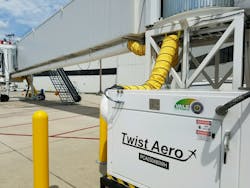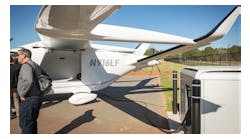Metropolitan areas across the country keep initiating projects to clean up the air and reduce pollution. While airports are only one part of the community, leaders can use efforts to clear the air to also upgrade equipment and bring a new level of service to the airfield.
Michael Thompson, director of facilities for the Birmingham Airport Authority, said the airport decided to look at improving air quality due to ozone and small particulate matter issues throughout Jefferson County, Ala.
Leaders decided to install charging equipment for ground support equipment, so airlines could convert to electric vehicles and in the process reduce emissions and operating costs. It was funded using part of a $2.5 million Federal Aviation Administration (FAA) Voluntary Airport Low Emission (VALE) program grant.
“We wanted to do our part and do what we could to reduce emissions in and around Jefferson County, so being good neighbors is one part,” he said. “The other part kind of tied into this sustainability aspect of our terminal modernization project and the fact that we now have an enclosed baggage make up area so with ground service equipment and tugs running constantly and exhaust fumes building up in that room, that was kind of the beginning of the idea of the project.”
Thompson said they didn’t look at any particular projects to model the Birmingham improvements on, but seeing as it was a VALE program, leaders were familiar with the project idea seeing as it was their fourth grant through the program.
“It all comes back to that terminal modernization program, which we got LEED Gold for,” he said. “It fit in with the 400 Hertz units and the aircraft AC units that we put in as part of the modernization project. It was all kind of a byproduct of that.”
Clean Air and New Equipment
John Trendowski, PE, principal engineer with C&S Companies, said VALE and other FAA and U.S. Environmental Protection Agency (EPA) grants provide funding mechanisms to improve the environment and air quality on airport property. One of the challenges the airports face is timing and meeting the FAA schedules to get the grant applications in in order to move the projects forward.
Airports in general have focused on electrical and preconditioned air projects as part of VALE grants, he said, which are a lot more cost effective.
“We see a lot more interest in terms of electrification of ground support equipment,” Trendowski said. “Ground support is kind of the next phase where you can achieve some significant emissions reductions either through electrifying or converting to some sort of alternative fuel and moving away from diesel.
Ralph Redman, EV SP, managing planner for C&S Companies, said the two biggest forms of emissions at the airport come from the aircraft and ground transportation. Lessening either of those two sources can be beneficial compared to replacing stationary equipment, such as boilers or generators, which are not as cost effective to replace.
“When you’re taking into account the VALE money is really dictated on what the cost effectiveness of it is, how much is FAA willing to give out versus how much emissions is being saved,” he said. “Those are the projects that score really high in the hierarchy of the VALE funding so of course you want to go after that.”
Redman said more and more airlines are hopping onto these programs as well because they recognize the benefits to them and are now taking these opportunities to the airports to make changes.
Trendowski said a lot of the requests for electrification of ground support equipment has come from large hub airports because the airlines are taking initiative on the project because they have more ground support equipment at the larger hubs.
“It’s starting to move down to the medium hubs in the future,” he said. “Whether it goes to the small hubs it may be difficult because a lot of those have fixed base operators that work for a number of airlines.
“But one of the advantages out there when talking about VALE, if you’re a small hub, they’ll pay for 90 percent of the cost of the project compared to medium and large hubs where FAA is matching only 75 percent.”
Redman said the record keeping to follow on the VALE project can scare some airport sponsors away, but proper planning can make it easy to continue with.
“If you are going to use the emissions reduction credits in the future, there’s certainly a lot of follow on coordination with the local air quality district to be able to apply those,” he said.”
When planning the charging stations, Thompson said they initially started talking with Delta Air Lines and Southwest Airlines, which are the two biggest carriers at Birmingham. The airport initially planned to start small with the project with 10 to 12 total chargers, but after seeing what the airlines wanted, they ended up putting in 27 charging stations.
The airlines supported the project, Thompson said because a conversion to electric vehicles reduced maintenance issues and the reduction of costs in fuel. Birmingham provides electricity to recharge the ground support equipment at no charge.
“They wanted to do the full program upfront,” he said. “The locations and logistics weren’t so much of an issue as was getting them into that capital expenditure was a little bit of a challenge because we were in between their budgeting cycles, but once we fully explained the project to them, they took off and did all 27 charging stations.”
While both airlines were on board with a conversion to electric vehicles for ground support equipment, Thompson said there was a challenge in making the project work because both Delta and Southwest had charger preferences to work with their equipment. The authority put out RFP with two different specs. During the process, the airport learned it was able to find a solution to cut down on costs and maintenance.
“One company came back and said ‘hey we can actually meet both specs and the only thing that would really be required is an adaptor from the Delta side and we can have one charger that will meet both specs,” Thompson said.
Updates to Meet New Demands
David Whitaker, vice president-business development & communications for the Columbus Regional Airport Authority said a project concept came about after the leaders wanted to get ground power and air conditioning units to all the jet bridges at John Glenn International Airport (CMH) and have consistency of equipment on all of the bridges.
The authority reached an agreement to purchase the jet bridges from the airline carriers in 2010, Whitaker said. When the carriers purchased the units prior to the authority takeover, some decided to not put equipment on them and others used different types of equipment, which created challenges.
The agreement between the authority and air carriers said the airlines would pay the maintenance of the units and the airport would come up with a plan to standardize and have uniform equipment across all the bridges.
C&S Companies consulted Columbus on the design and Ameribridge Services Inc. also assisted in the project.
“The program provided that opportunity to help with the funding and also to help with the emission objectives,” he said. “It was a win-win in that sense. We were in a need for some equipment and desire to reduce our footprint and to form to the federal VALE program, to meet the criteria and be successful.”
Whitaker said after Columbus took control of the bridges, it began a program of retrofitting units and replacing bridges that were at the end of lifecycle under an aggressive plan.
“It did turn out in that assessment we had a great need for additional units,” he said. “By evaluating the program criteria we determined that we would be eligible for 13 ground power units and 11 preconditioned air units.”
Whitaker said Columbus had 11 bridges that didn’t have air but the process of getting the equipment was pretty straightforward. The ground power side was a little more complicated because the equipment needs to line up with the type of equipment being used by the carrier coming into the gate.
“If you had a ground power unit that wasn’t meeting the requirements of the plane that was using the gate you were eligible for a new one, but you couldn't replace one ground power for another unless you had a demand for it, such as right aircraft type,” he said.
Some of the old GPUs were either straight DC or AC power units. The new ones can work for both.
Columbus also discovered it needed additional electrical capacity for the program, which meant the airport needed a needed a new substation. That was an ineligible part of the program.
Claypool Electric installed the substation.
The authority also needed to consult with Delta, American Airlines and Frontier Airlines for the substation project.
“We needed a location for a substation and much of the airport is at full capacity, so we had to find those areas and find those pathways, conduit pathways coordination for that,” Whitaker said.
Ray Fridley, project manager-planning and engineering for the authority, said the new systems are also hooked into the airport’s monitoring system to give operators a new view on how the equipment is being used.
“Not only does that tell us what energy system we’re using, but it also gives us a picture about the way that jet bridges are being used,” Kennedy said. “They weren’t metered independently and some of the equipment was owned by the airlines so this transition to the airport authority control of those assets gives us better visibility both from the energy and the maintenance standpoint, so we have a much more visible awareness of how those assets are being used today than we did before.”
Create Partners in Challenges
Dale Stubbs, associate vice president-market sector manager for AECOM said they were trying to be flexible with the airlines in meeting their needs and through the competition of the bid process when the adaptor solution came forward to meet the needs of both while reducing costs.
Thompson said they were the intermediary with the airlines to coordinate between the vendor and company to address concerns with the one charger working for both of them.
“To my knowledge, I don’t know if they’ve done that in any other application,” he said. “They certainly weren’t aware that that charger could work with both given the adaptor kits.”
When planners were laying out the locations for the chargers at each gate, Thompson said they had to make sure they were accessible while not interfering with other operations. Because of the work done on the terminal the process was expedited, Stubbs said, due to the terminal modernization project.
“There was an extensive effort at the beginning of the design to really identify where we were going to put them, how we were going to get power to them and that worked out very well,” he said.
Neal Wolfe, who was an environmental consultant at the time of the project with LeighFisher, said there was a challenge in the time perspective of the project because the Federal Aviation Administration (FAA) was late in giving notice to proceed with the project. Normally, it would take six months to get it done, but Birmingham had three months.
“Surpassingly, one of the more challenging things is coordinating with the airlines and figuring out when they were delivering their equipment,” he said. “I was very pleasantly surprised in working with them and the FAA on the timing of this.”
Darcy Zarubiak, who was also a consultant with LeighFisher on the project, said the Birmingham project is especially noteworthy because there are not a lot of airports of that size undertaking GSE electrification projects and because the airlines committed to owning this new equipment for 13 years as part of the grant.
“This is very good project, this is a model of what should happen, the finance work on it, but yet it’s not happening,” he said. “It’s not happening because it takes that extra effort to make such a project happen.”




